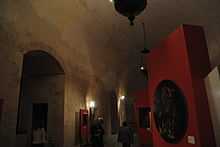Sicilian Regional Assembly
| Sicilian Regional Assembly Assemblea Regionale Siciliana | |
|---|---|
| 16th Legislature | |
| Type | |
| Type |
Unicameral |
| History | |
| Founded | May 25, 1947 |
| Leadership | |
President |
Giovanni Ardizzone, UDC since December 5, 2012 |
| Structure | |
| Seats | 90 |
 | |
Political groups |
Government (44)
Opposition (46) |
| Elections | |
Last election | October 28, 2012 |
| Meeting place | |
 | |
| Sala d'Ercole, Palazzo dei Normanni, Palermo | |
| Website | |
The Sicilian Regional Assembly is the legislative body of Sicily. While it has a long history as an autonomous region, the modern Region of Sicily was established by Royal Decree on May 15, 1946, before the Italian Republic. The Regional Assembly has the widest legislative power in Italy and is the only regional assembly to have the title of "parliament" whose members are called "deputies" like those in Rome. Ninety deputies are elected every five years in the nine provinces.[1]
History

The Sicilian Parliament is considered one of the oldest in the world[2][3] (together with that Icelandic[4] and faroese,[5] which, however, had no decision-making powers, a fact which makes the Sicilian Parliament the first in the modern sense). In 1097 came the first conference in Mazara del Vallo convened by Roger I the Great Count of a parliament initially travelling. The Sicilian Parliament was made up of three branches: from feudalism, from the Ecclesiastical and from the State Property. The feudal branch was formed by nobles representatives of counties and baronies, the ecclesiastical branch was formed by archbishops, bishops, abbots and archimandrites, while the state-owned branch was formed by representatives of 42 autonomous towns in Sicily. The first Norman parliament was not a deliberative, and had only an advisory function and confirmation of the sovereign, especially in taxation, economics and wars. Members were chosen from the more powerful nobles.
Since 1130 we finally meet in Palermo, in Palazzo dei Normanni. First radical change came with Frederick II of Swabia, which allowed the access part to civil society. After a period in the background during the reign of Anjou, the Parliament became the central focus of the organization of the Sicilian Vespers. On 3 April 1282, during the uprising, the red and yellow flag with the center triscele was adopted by Parliament: today is the flag of Sicily. With the Vespers and the subsequent settlement of Frederick III of Aragon in 1297, the Assembly strengthened its central role. This was the time that the permanent establishment of the Parliament was in the Castello Ursino, in Catania, at the Sala dei Parlamenti (Parliaments Hall). At this time consisted primarily of landowners, mayors of cities from the counts and barons, was chaired and convened by the king. Parliament had the constitutional responsibility to elect the king and to perform the function of body guaranteeing the proper conduct of ordinary justice exercised by executioners, judges, notaries and other officials of the kingdom.
In 1410 the Sicilian Parliament held at Palazzo Corvaja of Taormina, in the presence of Queen Blanche I of Navarre, a historic meeting for the election of the King of Sicily after the death of Martin II. With the successive kings of Aragon, Sicily lost its political autonomy and a viceroy ruled the island. With Charles V in 1532 was again summoned a parliament in Palermo, which also continued to meet under Philip II, preserving its authority.
In Sicily the Bourbons ruled from Naples and found himself the function of Parliament is greatly reduced gradually until the revolution followed the riots of 1848, when it regained its centrality. In fact, Palermo, 25 March of that year, met the General Parliament of Sicily, with a revolutionary government composed of a president and ministers from the president himself eligible. Vincenzo Fardella of Torrearsa and then Ruggero Settimo were elected president: declared void the Bourbon dynasty and offered the vacant throne of Sicily to the Duke of Genoa, the second son of Carlo Alberto of Savoy, who would not. The life of the Parliament of 1848-49 lasted briefly and already the so-called Gaeta decree of 28 February 1849 Ferdinand II of the Two Sicilies began to take possession of Sicily, and the assize was dissolved a few months later.
Reconstitution of the Parliament came at the end of World War II, when for the vast defuse separatist movement in Sicily, was granted special autonomy and was reborn, 25 May 1947, as the Sicilian Regional Assembly. In 1997 the Assembly celebrated its 900th anniversary as the first assembly was convened in 1097. On 26 January 2008, for the first time in republican history, the Assembly is dissolved by the resignation of President Salvatore Cuffaro of the region.
Seat
The Assembly has its seat in the prestigious Palazzo Reale in Palermo. It was constructed in the 11th century with the Norman conquest of Sicily and has seen several expansion and renovation operations. It hosted the kings of Sicily, including Frederick II of Swabia, and later the viceroy of Spain. Adjacent is the Palatine Chapel. The tourist services in the Palace and the Palatine Chapel are entrusted to the Foundation Frederick II.
Composition
The Assembly is composed of ninety deputies elected by direct universal suffrage every five years by voters in Sicily. From 25 May 1947 to now there were XV legislatures, initially for a period of four years, while in 1971 five years. For the first time the XIV^ legislature ended prematurely in 2008 due to the resignation of the President of the region, Salvatore Cuffaro. The electoral mechanism, which includes a barrier of 5% of the list, provide for the provincial colleges of 80 members plus the president-elect and a candidate for president most votes among the non-elect. The remaining eight seats are allocated to the majority share to reach 54 members, otherwise, if it has been already achieved, are given as a reward minority (as they did in 2008).
Presidents[6]
- I legislatur: Ettore Cipolla (1947-1951)
- II : Giulio Bonfiglio (1951-1955)
- III : Giuseppe La Loggia (1955-1956), Giuseppe Alessi (1956-1959)
- IV : Ferdinando Stagno D'Alcontres (1959-1963)
- V : Rosario Lanza, (1963-1967)
- VI : Rosario Lanza, (1967-1971)
- VII : Angelo Bonfiglio (1971-1974),Mario Fasino (1974-1976)
- VIII : Pancrazio De Pasquale, (1976-1979), Michelangelo Russo (1979-1981)
- IX : Salvatore Lauricella, (1981-1986)
- X : Salvatore Lauricella, (1986-1991)
- XI : Paolo Piccione (1991-1993), Angelo Capitummino (1993-1996)
- XII : Nicola Cristaldi (1996-2001)
- XIII : Guido Lo Porto (2001-2006)
- XIV : Gianfranco Miccichè (2006-2008)
- XV : Francesco Cascio (2008-2012)
- XVI : Giovanni Ardizzone (2012-actual)
References
- ↑ Regleg. Sicily. EU political regions.
- ↑ Storia del Parlamento - Il Parlamento
- ↑ Enzo Gancitano, Mazara dopo i Musulmani fino alle Signorie - Dal Vescovado all'Inquisizione, Angelo Mazzotta Editore, 2001, p. 30.
- ↑ "Hurstwic: Viking-age Laws and Legal Procedures".
- ↑ "The Faroese Parliament" (PDF).
- ↑ http://www.ars.sicilia.it/presidenza/presidenti/default.jsp
| ||||||||||||||||||
Coordinates: 38°06′40″N 13°21′10″E / 38.11111°N 13.35278°E